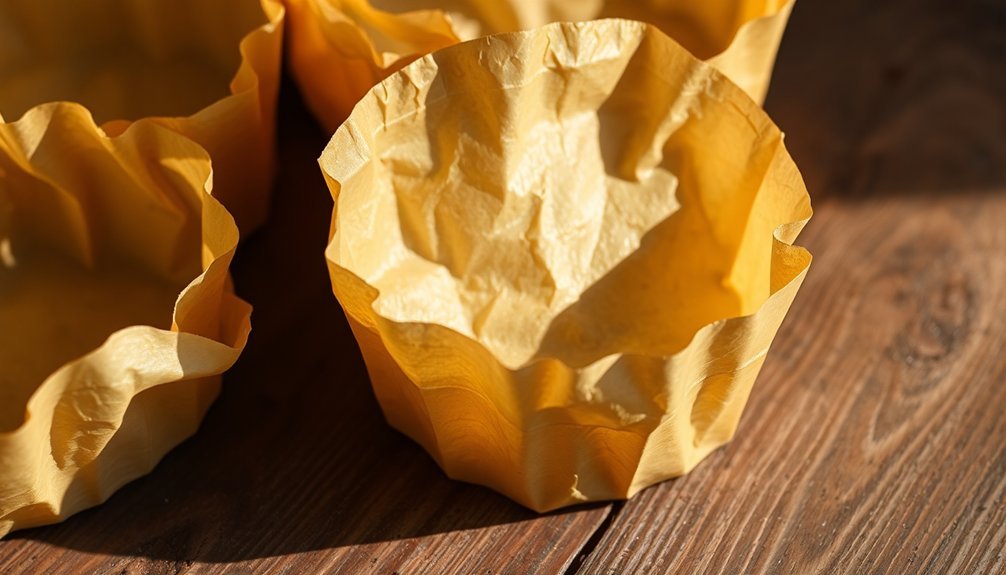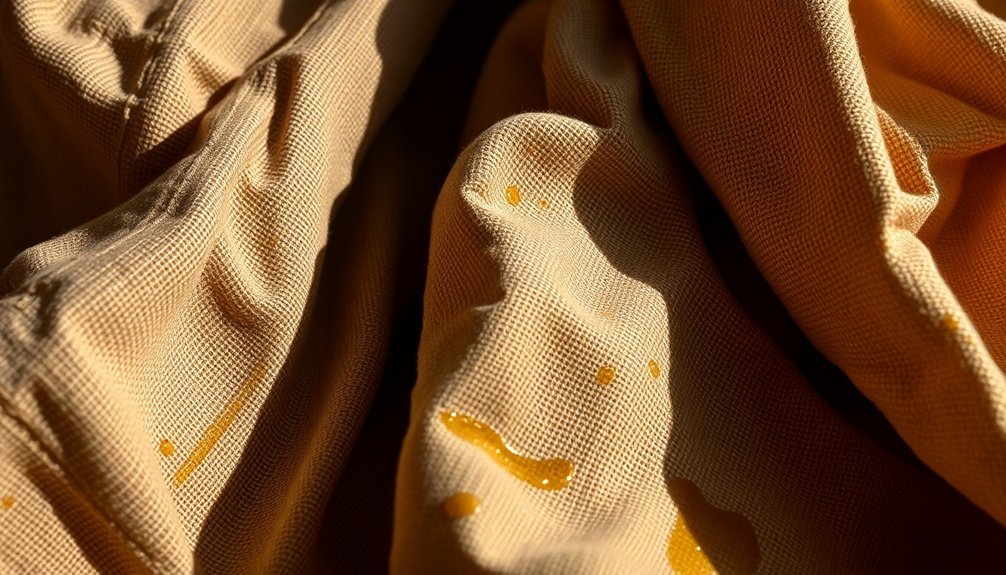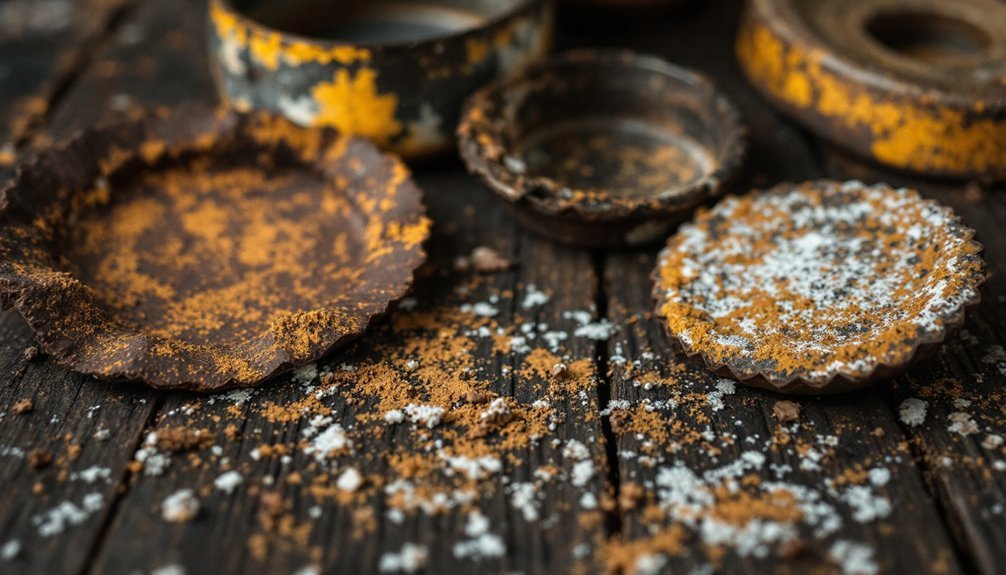Throughout history, artisans used ingenious natural mold liners including beeswax-coated wooden trays from Victorian New England, oiled parchment paper in medieval cooking, natural clay liners in Mediterranean soap-making, olive oil dampened cloth since 500 BCE, plant leaves for pottery impressions, animal fat-greased pottery vessels, and various leaf impressions for scientific documentation. These sustainable techniques protected molds, prevented sticking, and created unique textures. These clever solutions from our ancestors continue to inspire modern crafting and manufacturing approaches today.
7 Simple Mold Liners Used Throughout History

While we often take modern manufacturing methods for granted, mold liners have played an essential role in human craftsmanship for millennia. Dating back to 3000 BC, ancient civilizations incorporated basic modeling forms for decorative purposes, particularly in pottery production.
Mold liners: ancient ingenuity behind decorative craftsmanship that continues to shape production techniques today.
In early Babylonia, artisans used lined molds to imprint intricate designs on clay objects. Wooden molds, specifically chosen for their durability, were employed to cast edible items. As techniques evolved, different materials were selected based on intended use and environmental conditions.
You'll find that throughout history, craftspeople gradually advanced from simple lined forms to complex systems that eventually enabled mass production.
The choice of lining material was vital – protecting both the mold itself and ensuring the finished product would release properly, a technique that's still fundamental in today's manufacturing processes.
Beeswax-Coated Wooden Trays
Artisans of the ancient world discovered that beeswax-coated wooden trays offered an ingenious solution to countless molding challenges. You'll find these trays were particularly popular during the Victorian Era in New England, where craftsmen valued their natural appearance and protective qualities. Similar to how modern soap makers use wooden molds with removable sides for easy soap extraction, these historical trays were designed with practicality in mind.
| Era | Primary Use | Advantages |
|---|---|---|
| Ancient | Food molding | Naturally non-stick |
| Medieval | Craft tools | Easy application |
| Victorian | Furniture making | Soft protective layer |
| Industrial | Manufacturing | Breathable coating |
| Modern | Sustainable crafts | Biodegradable |
Unlike modern plastic alternatives, beeswax-coated trays provided a breathable surface that prevented moisture buildup while being easily reapplied when worn. Though they lacked the durability of other finishes, their natural composition made them ideal for food-related applications where taste preservation was essential.
Oiled Parchment Paper From Medieval Recipes

Long before beeswax coatings became commonplace, medieval cooks had already developed ingenious mold liners using oiled parchment paper.
These early culinary innovators would carefully shape parchment into molds, adding oil to create non-stick surfaces for cooking eggs and other delicate foods.
You'll find fascinating references to this technique in medieval manuscripts like the Liber de Cocina, where recipes detail how to position these parchment liners safely over candles or hot coals.
The process required careful attention to prevent oil spillage and direct flame contact.
This clever method mirrors modern parchment paper usage but employed actual animal-hide parchment—the same material used for manuscripts and legal documents.
When adapting these historical techniques today, you'd be wise to use a fireproof bowl as a safety precaution.
Natural Clay Liners in Ancient Mediterranean Soaps
Ancient Mediterranean civilizations discovered that clay offered more than just pottery uses—it revolutionized their soap-making processes. They lined their molds with clay to prevent sticking while simultaneously enhancing their soaps with clay's natural cleansing properties.
These civilizations recognized that clay could absorb impurities without stripping skin of its natural oils, making it an ideal mold material and soap ingredient. Clay liners served a dual purpose: they facilitated easier soap removal and infused beneficial minerals into the final product.
You'll find this technique reflected in surviving historical recipes that combine bentonite, kaolin, and green clays with natural oils.
This traditional method influenced modern soap-making practices, where artisans still use clay both as mold liners and active ingredients in small-batch, chemical-free productions tailored to different skin types.
Cloth Dampened With Olive Oil

You'll find cloth dampened with olive oil was a clever release technique used throughout the Mediterranean basin as early as 500 BCE.
Artisans would apply oil-soaked fabric to mold interiors, creating a non-stick surface that allowed for clean extraction of soaps, ceramics, and decorative plaster work.
This method proved particularly effective for intricate designs, as the oil-treated cloth could conform to detailed patterns while preventing the finished product from adhering to the mold.
Ancient Release Technique
Artisans in early civilizations developed ingenious solutions to prevent materials from sticking to molds. They discovered that olive oil applied to cloth created an effective natural release agent, demonstrating remarkable resourcefulness with limited materials.
This technique represents a fascinating intersection of practicality and innovation that solved adhesion problems before modern alternatives existed:
- The natural lubricating properties of olive oil reduced friction between surfaces.
- Cotton or wool fabrics provided an ideal application medium for the oil.
- The dampening process created a barrier that prevented sticking.
- This method predates modern silicone release agents by thousands of years.
While direct documentation of this specific technique is limited, the principles align perfectly with the problem-solving approaches evident throughout ancient craftsmanship.
Mediterranean Crafting Method
The Mediterranean Crafting Method emerged as a refinement of earlier release techniques, showcasing the region's innovative approach to mold-making challenges.
This technique involves dampening cloth—typically cotton or linen—with olive oil to create flexible, non-stick mold liners.
You'll find this method deeply rooted in Mediterranean resourcefulness, where craftspeople utilized locally available materials. The oil-soaked fabric could be shaped, dried, and reused multiple times, making it an economical choice for artisans.
While historical records specifically mentioning this technique are limited, the practice aligns perfectly with the region's tradition of sustainable craftsmanship.
The versatility of these liners extended beyond pottery to various domestic and agricultural applications, demonstrating how simple materials could solve complex crafting problems when combined with traditional knowledge.
Plant Leaf Impressions as Release Agents
Contrary to popular belief, plant leaves weren't historically used as mold release agents but were instead employed for botanical documentation through nature printing techniques dating back to the 14th century.
You'll find that leaf impressions appeared primarily in decorative pottery where artisans pressed actual leaves into clay to create aesthetic rather than functional patterns.
These natural mold-making methods remained largely artistic endeavors, as leaves' fragile structure made them unsuitable for industrial applications that required durable release agents like waxes or silicones.
Early Botanical Documentation Methods
Long before modern scientific methods emerged, botanists meticulously documented plant characteristics through various physical techniques that would later influence industrial applications.
Plant leaf impressions became fundamental tools for studying leaf morphology, venation patterns, and taxonomic classifications. You'd find these impressions preserved in herbaria, where they've aided scientists in tracking botanical variations over centuries.
- Botanists created impressions by pressing leaves between paper sheets, capturing minute details essential for identification.
- These documented impressions helped establish evolutionary relationships between plant species.
- Leaf impressions simultaneously served scientific documentation and artistic expression.
- While technology has evolved with digital imaging and 3D printing, the basic technique remains valuable in field studies.
Decorative Pottery Impressions
During the early development of decorative pottery, craftspeople discovered that plant leaves served as excellent natural mold liners or "release agents."
You'll find that when pressed into soft clay, leaves create remarkably detailed impressions that capture their intricate venation patterns, textures, and outlines.
Ferns, beech, maple, and rhubarb leaves are particularly valued for their distinctive textures.
To create these impressions, you'll position leaves artfully on white clay, press them in using rollers, then allow the clay to reach a leather-hard state before removing the leaves.
After bisque firing at Cone 04, you can enhance the leaf details using transparent glazes or by wiping back underglazes from raised areas.
This technique differs from botanical printing, emphasizing texture rather than color transfer in the finished ceramic piece.
Natural Mold-Making Techniques
While pottery impressions utilized leaves for decorative effects, ancient metalworkers discovered that certain plant leaves could serve as effective mold liners and release agents in casting processes.
These natural materials provided both practical functionality and unique aesthetic results.
- Waxy Protection: Leaves with naturally waxy surfaces, particularly from succulents, prevented molten metal from adhering to clay molds.
- Detailed Impressions: Plant materials created intricate textures impossible to achieve by hand carving.
- Regional Techniques: Different cultures developed unique approaches based on locally available flora.
- Sustainable Practice: Early craftspeople used these biodegradable materials in a process that modern sustainable casting still draws inspiration from today.
This bio-inspired technology allowed ancient metalworkers to produce complex designs with minimal tools, demonstrating remarkable ingenuity in leveraging nature's properties for technological advancement.
Animal Fat-Greased Pottery Vessels
Though often overlooked in archaeological discussions, animal fat-greased pottery vessels represent one of humanity's earliest functional innovations. When you examine ancient ceramics, you'll find they weren't just cooking vessels—they served multiple technological purposes.
Through organic residue analysis, archaeologists can detect fatty molecules that have seeped into porous pottery surfaces. These lipids remain remarkably stable for millennia, resistant to soil microorganisms and environmental degradation. The preservation of these fats provides vital insights into historical practices.
Ancient lipids in pottery tell silent stories, preserved for thousands of years despite nature's relentless decomposition processes.
You can trace this technology from Neolithic settlements to medieval times, where animal fats—particularly pig lard—were used not only for cooking but also for industrial applications.
The greasing of pottery with animal fats improved their functionality, reduced sticking, and helped preserve contents—techniques that would influence material technology for centuries to come.
Frequently Asked Questions
How Long Do Traditional Mold Liners Typically Last Before Replacement?
Traditional mold liners typically last 2-5 years, but you'll find this varies based on your materials, usage frequency, maintenance practices, and environmental conditions. Regular inspections will help you determine ideal replacement timing.
Can Historical Mold Liner Techniques Be Safely Used With Modern Materials?
Yes, you can safely use historical mold liner techniques with modern materials. You'll need to adapt processes for plastics and composites, but they often improve durability while maintaining traditional craftsmanship's unique aesthetic qualities.
Were There Regional Variations in Mold Liner Ingredients Across Cultures?
Yes, you'll find diverse mold liner ingredients across cultures – from Europe's butter and dairy products to Asia's sesame oil, Africa's coconut oil, and the Americas' vegetable oils, all based on local availability.
How Did Temperature Control Affect Historical Mold Liner Effectiveness?
Temperature control considerably impacted your mold liner effectiveness historically. You'd notice poor temperature regulation caused inconsistent release properties, degraded organic ingredients faster, and affected your liner's durability when temperatures exceeded material-specific thresholds.
What Tools Were Used to Apply Early Mold Release Agents?
You'd apply early mold release agents using traditional tools like brushes, rags, and mops. Later, aerosol sprays became popular, while specialized applicators like cloths, wax-filled rags, and microfiber were used for precise distribution.
In Summary
You've now discovered seven ingenious mold liners our ancestors used for centuries. From beeswax-coated trays to animal fat-greased pottery, these simple solutions relied on natural materials readily available in their time. Next time you're creating something that needs unmolding, you might try one of these historical techniques. They've withstood the test of time and prove that sometimes the simplest solutions are the most effective.





Leave a Reply